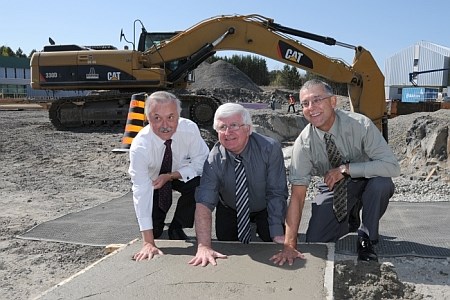Collège Boréal is once again putting shovels in the ground at its Sudbury campus, where construction has begun on a $22-million, 89,000-square-foot building to house a raft of new trades programs.
As industry continues to knock on its door for skilled graduates, the college will increase its local footprint to 417,000 square feet with its new Institute of Trades, allowing for the introduction of new French trades programs in the fall of 2011.
These additions include the milling machinist, masonry, health and safety, and painter/decorator programs. Culinary arts and stage technician programs will also be introduced.
“Mining firms in the North were looking at having major problems because of retirements and just a lack of people going into the trades, and that’s why we’ve put a lot of effort into the trades,” says Danielle Talbot-Lariviere, vice-president of Les Entreprises Boréal at the college.
“If you think of masonry, they’re having problems with bricklayers and masons as there aren’t any new ones coming out. Once the older fellas that are doing this trade are done, there’ll be nobody to take over, and it’s very hard even to find drywallers to do individual projects here in Sudbury.”
Once complete, the new facility will add 500 students to the campus’ current total of 1,000, and create 25 new jobs. Designed by ANO Architects, the new facility will also link the body of the main campus with the college’s existing trades building, which was completed in 2006 and filled to capacity by rising demand.
With offices in Sudbury and Timmins, the company has a history of work with Collège Boréal, having designed its main campus in a 1999 joint venture with Bywater Mitchell Architects Inc. and Larocque Elder Architects Inc.
ANO Architects’ more recent involvement with the college includes the design of the school’s second residence, which began construction in the summer of 2009.
Construction of the new trades facility is being overseen by the Mississauga-based Century Group Inc., though all subcontractors are being drawn from the North.
As part of the school’s growing focus on integrating a “green” focus throughout the institution’s programs and facilities, officials are looking at the potential to introduce sustainable energy systems throughout the new trades building. This will include making use of geothermal heating systems, while the solar energy is being considered as a means of powering the site’s new electronics training area.
The same approach will be used in the design of the new programs. For example, the culinary arts program is being mandated to use nothing but local produce.
“Thinking green is not just in our programs, but also in the way we’re doing business.”
The construction of the new trades facility will also enable officials to clear space in the existing facilities to begin making way for the project’s second phase. This will involve honing the college’s focus on health sciences,which is becoming increasingly popular in regions north of Timmins, such as Kapuskasing.
This popularity is due in part to the lower number of personal support workers and practical nurses in the region, says Talbot-Lariviere.
This type of measured, organic growth is important in preparing for the future of the school by opening more educational doors for francophone students, she says. Research done by Boréal has shown only 36 per cent of all programs offered in English are also offered in French, with Boréal losing on average 50 per cent of the region’s francophones to English-language colleges.
Officials have worked to change that ratio by promoting the francophone culture through internally promoted events and increasing the number of academic opportunities to the francophone community.
As an example, Boréal had two apprenticeship programs six years ago, a number which has since risen to 15.
“We’ve done a lot to ensure there are options,” says Talbot-Lariviere. “We’re always focused on access, which is important since we’re constantly having to meet the needs of different populations and industries.”




